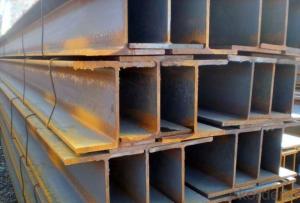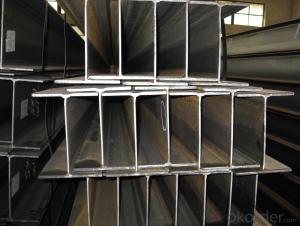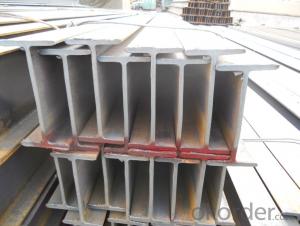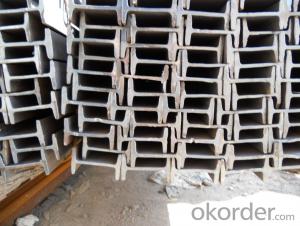carbon steel H BEAM for construction JIS G 3192
- Loading Port:
- Tianjin
- Payment Terms:
- TT or LC
- Min Order Qty:
- 25 m.t.
- Supply Capability:
- 100000 m.t./month
OKorder Service Pledge
OKorder Financial Service
You Might Also Like
Product Description:
OKorder is offering carbon steel H Beam for construction JIS G 3192 at great prices with worldwide shipping. Our supplier is a world-class manufacturer of steel, with our products utilized the world over. OKorder annually supplies products to European, North American and Asian markets. We provide quotations within 24 hours of receiving an inquiry and guarantee competitive prices.
Product Applications:
Carbon steel H Beam are ideal for structural applications and are widely used in the construction of buildings and bridges, and the manufacturing, petrochemical, and transportation industries.
Product Advantages:
OKorder's steel H Beam are durable, strong, and resist corrosion.
Main Product Features:
· Premium quality
· Prompt delivery & seaworthy packing (30 days after receiving deposit)
· Corrosion resistance
· Can be recycled and reused
· Mill test certification
· Professional Service
· Competitive pricing
Product Specifications:
1. Standard: JIS
2. Grade: SS400
3. Length: 12m
4. Invoicing on theoretical weight or actual weight as customer request
5.Payment: TT or L/C
6. Sizes:
H x B
(mm)
| T1 | T2 | JIS Weight
(kg/m)
| GB Weight
(kg/m)
|
100*100 | 6 | 8 | 16.9 | 17.2 |
125*125 | 6.5 | 9 | 23.6 | 23.8 |
150*75 | 5 | 7 | 14 | 14.3 |
148*100 | 6 | 9 | 20.7 | 21.4 |
150*150 | 7 | 10 | 31.1 | 31.9 |
175*90 | 5 | 8 | 18 | 18.2 |
175*175 | 7.5 | 11 | 40.4 | 40.4 |
198*99 | 4.5 | 7 | 17.8 | 18.5 |
200*100 | 5.5 | 8 | 20.9 | 21.7 |
194*150 | 6 | 9 | 29.9 | 31.2 |
200*200 | 8 | 12 | 49.9 | 50.5 |
248*124 | 5 | 8 | 25.1 | 25.8 |
250*125 | 6 | 9 | 29 | 29.7 |
244*175 | 7 | 11 | 43.6 | 44.1 |
250*250 | 9 | 14 | 71.8 | 72.4 |
298*149 | 5.5 | 8 | 32 | 32.6 |
298*201 | 9 | 14 | 65.4 | |
300*150 | 6.5 | 9 | 36.7 | 37.3 |
294*200 | 8 | 12 | 55.8 | 57.3 |
300*300 | 10 | 15 | 93 | 94.5 |
346*174 | 6 | 9 | 41.2 | 41.8 |
350*175 | 7 | 11 | 49.4 | 50 |
340*250 | 9 | 14 | 78.1 | 79.7 |
350*350 | 12 | 19 | 135 | 137 |
400*200 | 8 | 13 | 65.4 | 66 |
390*300 | 10 | 16 | 105 | 107 |
400*400 | 13 | 21 | 172 | 172 |
446*199 | 8 | 12 | 65.1 | 66.7 |
450*200 | 9 | 14 | 77.9 | 79.5 |
440*300 | 11 | 18 | 121 | 124 |
496*199 | 9 | 14 | 77.9 | 79.5 |
500*200 | 10 | 16 | 88.2 | 89.6 |
488*300 | 11 | 18 | 125 | 129 |
596*199 | 10 | 15 | 92.5 | 95.1 |
600*200 | 11 | 17 | 103.4 | 106 |
588*300 | 12 | 20 | 147 | 151 |
700*300 | 13 | 24 | 182 | 185 |
800*300 | 14 | 26 | 207 | 210 |
900*300 | 16 | 28 | 240.1 | 243 |
FAQ:
Q1: How do we guarantee the quality of our products?
A1: We have established an advanced quality management system which conducts strict quality tests at every step, from raw materials to the final product. At the same time, we provide extensive follow-up service assurances as required.
Q2: Can stainless steel rust?
A2: Stainless does not "rust" as you think of regular steel rusting with a red oxide on the surface that flakes off. If you see red rust it is probably due to some iron particles that have contaminated the surface of the stainless steel and it is these iron particles that are rusting. Look at the source of the rusting and see if you can remove it from the surface.
Images:
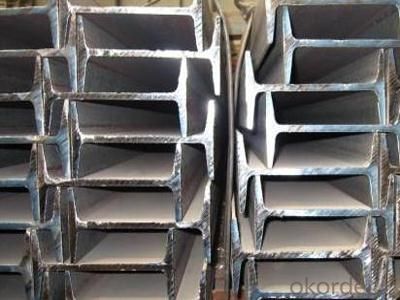
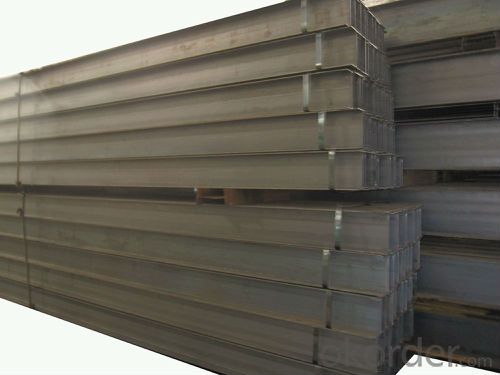

- Q:How do steel H-beams perform in extreme temperature variations?
- Steel H-beams perform well in extreme temperature variations due to their high thermal stability and low thermal expansion coefficient, which allows them to maintain their structural integrity and strength even in extreme heat or cold conditions.
- Q:How do you transport and install steel H-beams?
- Steel H-beams are typically transported using trucks or trailers equipped with cranes or forklifts. During installation, a crane is commonly used to hoist the beams into place, ensuring they are securely positioned and aligned according to the construction design.
- Q:What are the fire protection requirements for steel H-beams?
- The fire protection requirements for steel H-beams depend on various factors including the type of building, occupancy, and fire safety codes and regulations. However, in general, steel H-beams typically require fire protection to enhance their structural integrity in the event of a fire. The primary concern when it comes to fire protection for steel H-beams is preventing the steel from reaching its critical temperature, which can weaken the structural integrity of the beams. Fire protection measures are implemented to delay the heating of steel H-beams and prevent their premature failure during a fire. One common method of fire protection for steel H-beams is the application of fire-resistant coatings. These coatings are specifically designed to insulate the steel and delay its temperature rise by creating a barrier between the steel and the fire. Fire-resistant coatings can be applied to the exposed surfaces of the H-beams, providing a protective layer that slows down the transfer of heat to the steel. Another method of fire protection for steel H-beams is the use of fire-resistant encasement. This involves enclosing the H-beams within fire-rated materials, such as gypsum boards or concrete, to provide a physical barrier against the fire. The encasement acts as a shield, preventing direct exposure of the steel to the flames and heat. The fire protection requirements for steel H-beams will vary depending on the specific fire safety codes and regulations in place. These requirements may specify the type and thickness of fire-resistant coatings or encasement, as well as the duration of fire resistance required. It is important to consult with a qualified fire protection engineer or local fire safety authorities to determine the specific fire protection requirements for steel H-beams in a particular building or project. Compliance with these requirements ensures the safety and structural stability of the building in the event of a fire.
- Q:Are Steel H-Beams prone to corrosion or rust?
- Steel H-beams are not usually prone to corrosion or rust due to their composition. H-beams are typically made from carbon steel, which has a high resistance to corrosion. This is because carbon steel contains a high amount of iron and a small percentage of carbon, making it a durable material. Furthermore, H-beams are often coated with protective layers like zinc to enhance their resistance to corrosion. These coatings create a barrier that prevents moisture and oxygen from directly contacting the steel. Consequently, the likelihood of corrosion or rust developing on steel H-beams is minimal. However, it is important to note that if the protective coating becomes damaged or worn over time, the underlying steel may become susceptible to corrosion. Therefore, it is recommended to regularly inspect and maintain H-beams to ensure their long-term durability and resistance to rust.
- Q:Do steel H-beams require special maintenance?
- Steel H-beams do not typically require special maintenance. However, regular inspection and maintenance are recommended to ensure their structural integrity and longevity. This includes checking for any signs of corrosion or damage, such as cracks or bends, and addressing them promptly. Additionally, keeping the H-beams clean and free from debris or excessive moisture can help prevent corrosion and maintain their overall condition. Ultimately, while steel H-beams are known for their durability and strength, regular maintenance is essential to ensure their continued performance and safety.
- Q:Can steel H-beams be used for water treatment plants?
- Steel H-beams are indeed suitable for use in water treatment plants. They are a flexible and widely utilized structural element in different construction undertakings, including water treatment facilities. Their exceptional strength and resilience make them ideal for bearing heavy loads and enduring harsh environmental circumstances. In the realm of water treatment plants, steel H-beams can serve multiple purposes, such as forming the facility's framework, providing support for machinery and equipment, and establishing walkways and platforms. Moreover, steel H-beams can be effortlessly fabricated and tailored to meet precise design specifications, guaranteeing a perfect fit and optimal performance in the construction of water treatment plants.
- Q:Can steel H-beams be used in earthquake-prone areas?
- Yes, steel H-beams can be used in earthquake-prone areas. Steel is a strong and durable material that is widely used in construction, especially in areas prone to seismic activity. H-beams, also known as I-beams, are commonly used in structural steel construction due to their high strength-to-weight ratio and ability to withstand heavy loads. In earthquake-prone areas, buildings need to be designed and constructed to withstand the lateral forces and ground shaking caused by seismic activities. Steel H-beams are known for their excellent resistance to bending and torsion, making them ideal for withstanding these forces. Additionally, steel structures offer several advantages in earthquake-prone areas. Steel is flexible, allowing it to absorb and dissipate seismic energy, reducing the impact on the building. Furthermore, steel structures can be designed to have ductile behavior, meaning they can deform under seismic forces without collapsing, providing a higher level of safety. It is important to note that the design and construction of steel structures in earthquake-prone areas must adhere to strict building codes and regulations. These codes specify the required seismic performance levels and design criteria that ensure the safety of the building and its occupants during an earthquake. In conclusion, steel H-beams can be safely and effectively used in earthquake-prone areas when designed and constructed according to the appropriate building codes and regulations. Their strength, flexibility, and ductility make them an excellent choice for structures that need to withstand seismic forces.
- Q:Can steel H-beams be used for supporting swimming pool enclosures?
- Yes, steel H-beams can be used for supporting swimming pool enclosures. Steel H-beams are commonly used in construction for their strength and durability. They provide excellent support and can withstand heavy loads, making them suitable for supporting swimming pool enclosures. Additionally, steel H-beams are resistant to corrosion, which is crucial in a swimming pool environment where they will be exposed to water and chemicals. However, it is important to consult with a structural engineer or a professional contractor to ensure that the size and specifications of the steel H-beams are appropriate for the specific requirements of the swimming pool enclosure.
- Q:What are the typical fabrication tolerances for steel H-beams?
- The typical fabrication tolerances for steel H-beams can vary depending on the specific manufacturer and the intended application. However, generally speaking, the typical fabrication tolerances for steel H-beams range from +/- 1/8 inch to +/- 1/4 inch in terms of dimensional accuracy. This means that the actual dimensions of the H-beams can deviate within these tolerances from the specified dimensions.
1. Manufacturer Overview |
|
|---|---|
| Location | |
| Year Established | |
| Annual Output Value | |
| Main Markets | |
| Company Certifications | |
2. Manufacturer Certificates |
|
|---|---|
| a) Certification Name | |
| Range | |
| Reference | |
| Validity Period | |
3. Manufacturer Capability |
|
|---|---|
| a)Trade Capacity | |
| Nearest Port | |
| Export Percentage | |
| No.of Employees in Trade Department | |
| Language Spoken: | |
| b)Factory Information | |
| Factory Size: | |
| No. of Production Lines | |
| Contract Manufacturing | |
| Product Price Range | |
Send your message to us
carbon steel H BEAM for construction JIS G 3192
- Loading Port:
- Tianjin
- Payment Terms:
- TT or LC
- Min Order Qty:
- 25 m.t.
- Supply Capability:
- 100000 m.t./month
OKorder Service Pledge
OKorder Financial Service
Similar products
New products
Hot products
Related keywords
